
The Seminole Wars were a series of three military conflicts between the United States and the Seminoles that took place in Florida between about 1816 and 1858. The Seminoles are a Native American nation which coalesced in northern Florida during the early 1700s, when the territory was still a Spanish colonial possession. Tensions grew between the Seminoles and settlers in the newly independent United States in the early 1800s, mainly because enslaved people regularly fled from Georgia into Spanish Florida, prompting slaveowners to conduct slave raids across the border. A series of cross-border skirmishes escalated into the First Seminole War in 1817, when General Andrew Jackson led an incursion into the territory over Spanish objections. Jackson's forces destroyed several Seminole and Black Seminole towns and briefly occupied Pensacola before withdrawing in 1818. The U.S. and Spain soon negotiated the transfer of the territory with the Adams-Onis Treaty of 1819.

The Second Seminole War, also known as the Florida War, was a conflict from 1835 to 1842 in Florida between the United States and groups of people collectively known as Seminoles, consisting of American Indians and Black Indians. It was part of a series of conflicts called the Seminole Wars. The Second Seminole War, often referred to as the Seminole War, is regarded as "the longest and most costly of the Indian conflicts of the United States". After the Treaty of Payne's Landing in 1832 that called for the Seminole's removal from Florida, tensions rose until fierce hostilities occurred in the Dade battle in 1835. This conflict started the war. The Seminoles and the U.S. forces engaged in mostly small engagements for more than six years. By 1842, only a few hundred native peoples remained in Florida. Although no peace treaty was ever signed, the war was declared over on August 14, 1842.
The Battle of Lake Okeechobee was one of the major battles of the Second Seminole War. It was fought between 800 troops of the 1st, 4th, and 6th Infantry Regiments and 132 Missouri Volunteers, and between 380 and 480 Seminoles led by Billy Bowlegs, Abiaca, and Halpatter Tustenuggee (Alligator) on 25 December 1837. Halpatter Tustenuggee had played a major role in the Dade Battle two years earlier. The Seminole warriors were resisting forced relocation to a reservation in Oklahoma. Though both the Seminoles and Taylor's troops emerged from the battle claiming victory, Taylor was promoted to the rank of brigadier general as a result, and his nickname of "Old Rough and Ready" came mostly due to this battle.
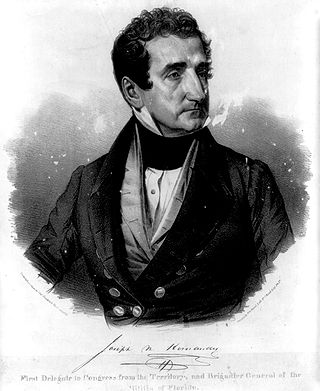
Joseph Marion Hernández was an American slave-owner, politician and military officer. He was the first delegate from the Florida Territory and the first Hispanic American to serve in the United States Congress. A member of the Whig Party, he served from September 1822 to March 1823.

Duncan Lamont Clinch (April 6, 1787 – December 4, 1849 was an American army officer and slave-plantation owner who served as a commander during the War of 1812, and First and Second Seminole Wars. In 1816, he led an attack on Negro Fort, the first battle of the Seminole Wars. Clinch later served in the United States House of Representatives, representing Georgia.

Mosquito County is the historic name of an early county that once comprised most of the eastern part of Florida. Its land included all of present-day Volusia, Brevard, Indian River, St. Lucie, Martin, Seminole, Osceola, Orange, Lake, Polk and Palm Beach counties.

Enterprise is an unincorporated community in Volusia County, in the U.S. state of Florida, and its former county seat. Situated on the northern shore of Lake Monroe, it is flanked by the cities of DeBary and Deltona. Enterprise was once the head of navigation on the St. Johns River and at various times, the county seat for three different counties: Mosquito, which was renamed as Orange; and lastly, for Volusia, which was formed from part of Orange County.
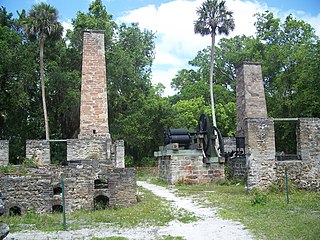
The Dunlawton Plantation and Sugar Mill, a 19th-century cane sugar plantation in north-central Florida, was destroyed by the Seminoles at the beginning of the Second Seminole War. The ruins are located at 950 Old Sugar Mill Road, Port Orange, Florida. On August 28, 1973, the site was added to the United States National Register of Historic Places under the title of Dunlawton Plantation-Sugar Mill Ruins.

The New Smyrna Sugar Mill Ruins is a historic site in New Smyrna Beach, Florida, at 600 Old Mission Road, one mile west of the Intracoastal Waterway. On August 12, 1970, it was added to the U.S. National Register of Historic Places.

Douglas Dummett (1806–1873) was an American planter, plantation owner, and politician. He served as a member of the Legislative Council of the Territory of Florida representing St. Johns County in 1843, and a member of the Florida House of Representatives representing Mosquito County in 1845. He was instrumental in developing the Indian River Citrus industry in Florida.
Uchee Billy or Yuchi Billy was a chief of a Yuchi band in Florida during the first half of the 19th century. Uchee Billy's band was living near Lake Miccosukee when Andrew Jackson invaded Spanish Florida during the First Seminole War and attacked the villages in the area. Yuchi Billy and his band then moved to the St. Johns River. During the Second Seminole War, Uchee Billy was an ally of the Seminoles, and was one of the principal war chiefs who fought the U.S. Army.

Hogtown was a 19th-century settlement in and around what is now Westside Park in Gainesville, Florida, United States where a historical marker notes Hogtown's location at that site and is the eponymous outpost of the adjacent Hogtown Creek. Originally a village of Seminoles who raised hogs, the habitation was dubbed "Hogtown" by nearby white people who traded with the Seminoles. Indian artifacts were found at Glen Springs, which empties into Hogtown Creek.
David Moniac, an American military officer, was the first Native American graduate of the United States Military Academy at West Point, New York in 1822. A Creek with some Scots ancestry, who was related to major Creek leaders on both sides of his family, Moniac was the first cadet to enter West Point from the new state of Alabama. Moniac resigned his commission in 1822 to manage his clan's property in Alabama, where he developed a cotton plantation.
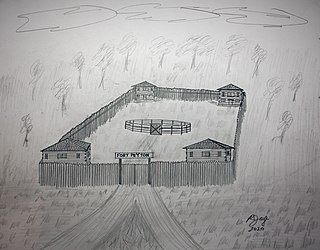
Fort Peyton was a stockaded fort built in August 1837 by the United States Army, one of a chain of military outposts created during the Second Seminole War for the protection of the St. Augustine area in Florida Territory. Established by Maj. Gen. Thomas Jesup, it was garrisoned by regular army troops.

The St. Joseph's Plantation was established in 1816 during the Second Spanish Rule (1783–1821) of Florida after Joseph Marion Hernandez purchased an 807.5-acre Spanish land grant. The forced-labor farm was located near the present-day intersection of Palm Coast Parkway and Old Kings Road in Palm Coast, Flagler County, Florida.
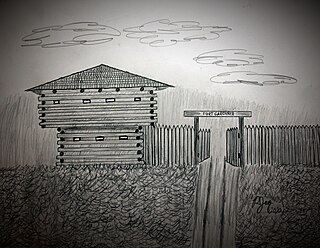
Fort Gardiner was a stockaded fortification with two blockhouses that was built in 1837 by the United States Army. It was one of the military outposts created during the Second Seminole War to assist Colonel Zachary Taylor's troops to capture Seminole Indians and their allies in the central part of the Florida Territory that were resisting forced removal to federal territory west of the Mississippi River per the Indian Removal Act.

Fort Basinger's original site is located approximately 35 miles (56 km) west of Fort Pierce, Florida, along U. S. Highway 98 in Highlands County, Florida. It was a stockaded fortification with two blockhouses that was built in 1837 by the United States Army. It was one of the military outposts created during the Second Seminole War to assist Colonel Zachary Taylor's troops to confront and capture Seminole Indians and their allies in the central part of the Florida Territory in the Lake Okeechobee region. The Seminole Indians and their allies were resisting forced removal to federal territory west of the Mississippi River as directed by the Indian Removal Act.
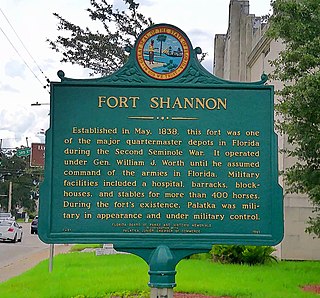
The Indian Removal Act provoked many Seminole Indians and their allies to revolt against being forcibly relocated from their lands and homes in the Florida Territory to Indian Territory west of the Mississippi River. After the Dade Massacre on December 28, 1835, the Second Seminole War was escalated with armed skirmishes and guerilla warfare. Early in the Second Seminole War, the strategically located town of Palatka, Florida Territory was attacked and burned by a group of Seminole Indians and their allies. Most surviving white settlers and black slaves fled to St. Augustine for safety, and the area was mostly abandoned except for free roaming groups of Seminole Indians and their allies. Realizing the importance of a militarily protected and efficient supply line along the St. Johns River General Walker Keith Armistead ordered the main depot moved from Garey's Ferry on Black Creek to Palatka where the U.S. Army built Fort Shannon.

Benjamin Alexander Putnam was a lawyer, state legislator, state surveyor, officer in the military during the Seminole Wars, judge, and president of the Florida Historical Society.
















